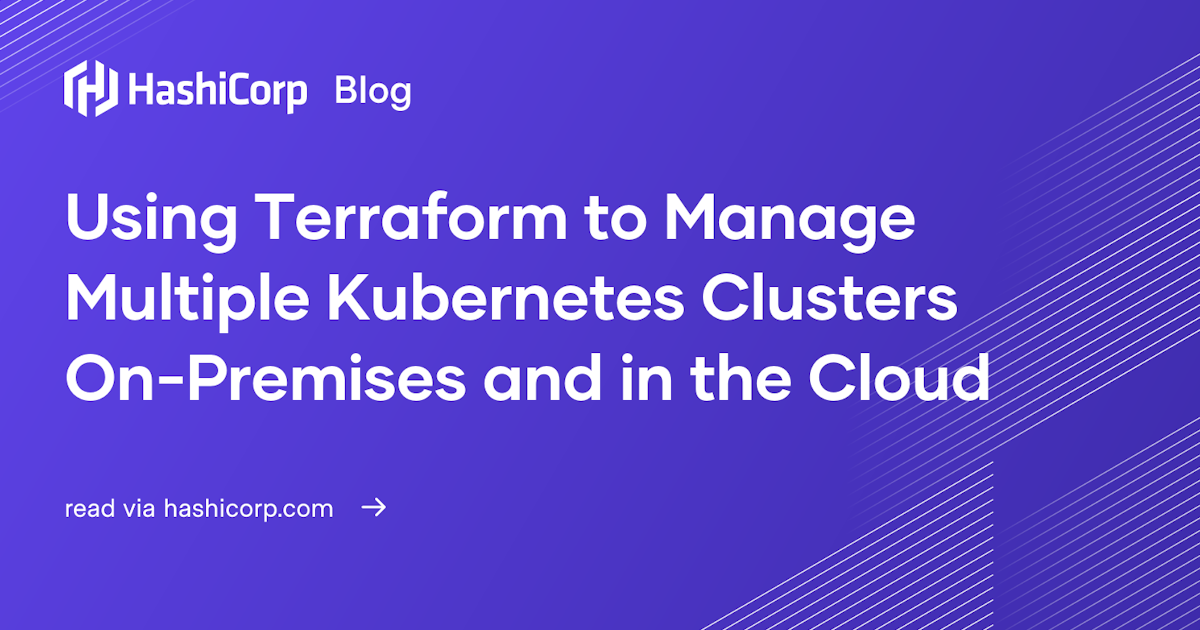Terraform for Multi-Cluster Kubernetes Management
Learn how to efficiently manage and deploy configurations across your Kubernetes clusters at scale using Terraform.
Learn how to efficiently manage and deploy configurations across your Kubernetes clusters at scale using Terraform.
Managing multiple Kubernetes clusters with Terraform requires a structured approach to configuration and deployment. This guide outlines the essential steps to seamlessly interact with multiple clusters within your Terraform code.
Define multiple Kubernetes providers: Use the alias argument within the kubernetes provider block to create distinct provider configurations for each cluster.
provider "kubernetes" {
alias = "cluster1"
# Cluster 1 configuration
}
provider "kubernetes" {
alias = "cluster2"
# Cluster 2 configuration
}Reference providers in resources: When defining resources that interact with your clusters, specify the target provider using the provider argument.
resource "kubernetes_deployment" "example" {
provider = kubernetes.cluster1
# Deployment configuration for cluster1
}
resource "kubernetes_service" "example" {
provider = kubernetes.cluster2
# Service configuration for cluster2
}Configure authentication: Ensure each provider block includes the necessary authentication details for its respective cluster (e.g., config_path, host, token).
Apply changes independently: You can manage resources on different clusters by running terraform apply with the -target option to focus on specific resources or providers.
terraform apply -target=module.cluster1
terraform apply -target=module.cluster2By following these steps, you can effectively manage multiple Kubernetes clusters using Terraform, keeping your configurations organized and deployments streamlined.
This code demonstrates managing two Kubernetes clusters using Terraform. It defines two Kubernetes providers, each configured with authentication details for a specific cluster. Resources are then defined and associated with a specific provider using the 'provider' argument. This allows for independent deployment and management of resources on each cluster. The example deploys an Nginx deployment on one cluster and exposes it as a service on the other, showcasing targeted resource application using the '-target' option with 'terraform apply'. This setup can be further organized using modules, variables, and outputs for better reusability and handling of complex deployments across multiple Kubernetes clusters.
This example demonstrates how to manage two Kubernetes clusters using Terraform.
1. Define Provider Configurations:
# Configure provider for Cluster 1
provider "kubernetes" {
alias = "cluster1"
config_path = "~/.kube/config" # Path to kubeconfig for cluster1
# Alternatively, use individual authentication details:
# host = "https://cluster1.example.com"
# token = "YOUR_CLUSTER1_TOKEN"
}
# Configure provider for Cluster 2
provider "kubernetes" {
alias = "cluster2"
host = "https://cluster2.example.com"
token = "YOUR_CLUSTER2_TOKEN"
}2. Define Resources and Specify Providers:
# Deploy Nginx on Cluster 1
resource "kubernetes_deployment" "nginx_deployment_cluster1" {
provider = kubernetes.cluster1
metadata {
name = "nginx-deployment-cluster1"
}
spec {
replicas = 2
selector {
match_labels = {
app = "nginx-cluster1"
}
}
template {
metadata {
labels = {
app = "nginx-cluster1"
}
}
spec {
container {
image = "nginx:latest"
name = "nginx"
}
}
}
}
}
# Expose Nginx on Cluster 2
resource "kubernetes_service" "nginx_service_cluster2" {
provider = kubernetes.cluster2
metadata {
name = "nginx-service-cluster2"
}
spec {
selector = {
app = "nginx-cluster2"
}
port {
port = 80
target_port = 80
}
}
}3. Apply Changes Independently:
# Apply changes to Cluster 1 resources
terraform apply -target=kubernetes_deployment.nginx_deployment_cluster1
# Apply changes to Cluster 2 resources
terraform apply -target=kubernetes_service.nginx_service_cluster2Explanation:
kubernetes providers with aliases cluster1 and cluster2.config_path or individual credentials).kubernetes_deployment and kubernetes_service specify the target provider using the provider argument.-target option with terraform apply.This example demonstrates a basic setup. You can expand it by:
By following these practices, you can effectively manage multiple Kubernetes clusters with Terraform, ensuring clear separation and streamlined deployments.
Organization and Reusability:
Best Practices:
Advanced Concepts:
Troubleshooting:
terraform plan command to preview changes before applying them. This helps identify potential resource conflicts or unintended consequences.By following these notes and best practices, you can effectively manage multiple Kubernetes clusters with Terraform, ensuring a robust and scalable infrastructure for your applications.
This article outlines a strategy for managing multiple Kubernetes clusters using Terraform. Here's a breakdown:
1. Define Separate Providers:
alias argument within the kubernetes provider block to create distinct configurations for each cluster.2. Reference Providers in Resources:
provider argument to specify the target cluster.3. Configure Authentication:
config_path, host, token, or other relevant settings.4. Apply Changes Independently:
-target option with terraform apply to manage resources on specific clusters independently.Benefits:
This approach enables a structured and efficient way to manage multiple Kubernetes clusters using Terraform. By defining separate providers for each cluster, referencing them in resource definitions, and leveraging Terraform's capabilities for targeted deployments, you can achieve better organization, streamlined workflows, and independent control over your infrastructure. This method is particularly beneficial for organizations operating in multi-cluster environments, allowing for scalability, flexibility, and easier management of complex deployments. Remember to incorporate best practices like using modules, variables, and remote state management for a robust and maintainable infrastructure as code setup.
 Terraform and Kubernetes – Working with Multiple Clusters ... | Oct 26, 2020 ... In this post we're looking at how to handle authentication for multiple Kubernetes clusters in Terraform. ... # Configure Providers using Return ...
Terraform and Kubernetes – Working with Multiple Clusters ... | Oct 26, 2020 ... In this post we're looking at how to handle authentication for multiple Kubernetes clusters in Terraform. ... # Configure Providers using Return ... Multicloud using terraform - Terraform - HashiCorp Discuss | how to create/manage a multi-cloud environment using terraform?
Multicloud using terraform - Terraform - HashiCorp Discuss | how to create/manage a multi-cloud environment using terraform? Manage Kubernetes resources via Terraform | Terraform ... | This Terraform configuration will schedule a NGINX deployment with two replicas on your Kubernetes cluster, internally exposing port 80 (HTTP). kubernetes.tf.
Manage Kubernetes resources via Terraform | Terraform ... | This Terraform configuration will schedule a NGINX deployment with two replicas on your Kubernetes cluster, internally exposing port 80 (HTTP). kubernetes.tf. Manage Kubernetes | Provision and manage Kubernetes clusters on AWS, Microsoft Azure, or Google Cloud, and interact with your cluster using the Kubernetes Terraform provider.
Manage Kubernetes | Provision and manage Kubernetes clusters on AWS, Microsoft Azure, or Google Cloud, and interact with your cluster using the Kubernetes Terraform provider. Deploying Multiple Environments with Terraform | by Chris Pisano ... | Terraform is a great tool for provisioning immutable infrastructure. It allows you to create infrastructure programmatically in a…
Deploying Multiple Environments with Terraform | by Chris Pisano ... | Terraform is a great tool for provisioning immutable infrastructure. It allows you to create infrastructure programmatically in a… Using Terraform to Manage Multiple Kubernetes Clusters On ... | Sep 10, 2020 ... Recently, a SaaS company in the operations software industry needed the ability to provision and manage multiple Kubernetes clusters both ...
Using Terraform to Manage Multiple Kubernetes Clusters On ... | Sep 10, 2020 ... Recently, a SaaS company in the operations software industry needed the ability to provision and manage multiple Kubernetes clusters both ... Spawn multiple hubs in the same kubernetes cluster using Helm ... | Using Terraform to deploy Jupyterhub on GKE. Following the Zero to Jhub on Kubernetes, so I’m using Helm to deploy it, but configured with Terraform. This works great if I’m deploying a single hub in a single cluster. But now, I want to deploy multiple hubs in the same cluster. I believe I can separate this out using namespaces. Is this as easy as creating another helm_release but using a different namespace?
Spawn multiple hubs in the same kubernetes cluster using Helm ... | Using Terraform to deploy Jupyterhub on GKE. Following the Zero to Jhub on Kubernetes, so I’m using Helm to deploy it, but configured with Terraform. This works great if I’m deploying a single hub in a single cluster. But now, I want to deploy multiple hubs in the same cluster. I believe I can separate this out using namespaces. Is this as easy as creating another helm_release but using a different namespace?